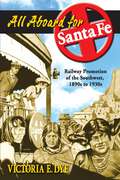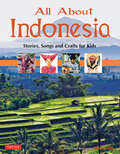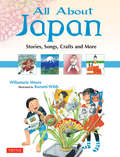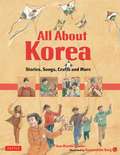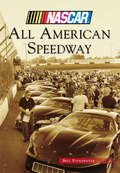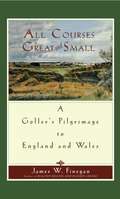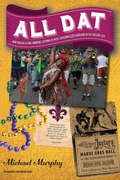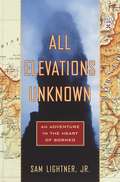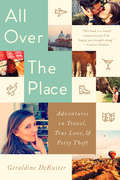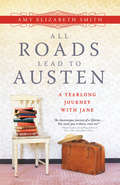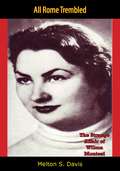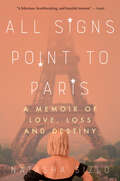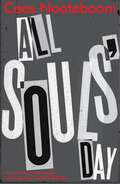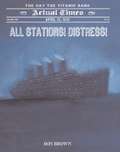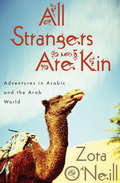- Table View
- List View
Alive: The Story of the Andes Survivors
by Piers Paul ReadTrue story about how a group of people who survived an airplane crash in the Andes had to resort to cannibalism in order to stay alive. Copyright © Libri GmbH. All rights reserved.
All Aboard for Santa Fe: Railway Promotion of the Southwest, 1890s to 1930s
by Victoria E. DyeBy the late 1800s, the major mode of transportation for travelers to the Southwest was by rail. In 1878, the Atchison, Topeka, and Santa Fe Railway Company (AT&SF) became the first railroad to enter New Mexico, and by the late 1890s it controlled more than half of the track-miles in the Territory. The company wielded tremendous power in New Mexico, and soon made tourism an important facet of its financial enterprise.All Aboard for Santa Fe focuses on the AT&SF's marketing efforts to highlight Santa Fe as an ideal tourism destination. The company marketed the healthful benefits of the area's dry desert air, a strong selling point for eastern city-dwelling tuberculosis sufferers. AT&SF also joined forces with the Fred Harvey Company, owner of numerous hotels and restaurants along the rail line, to promote Santa Fe. Together, they developed materials emphasizing Santa Fe's Indian and Hispanic cultures, promoting artists from the area's art colonies, and created the Indian Detours sightseeing tours. All Aboard for Santa Fe is a comprehensive study of AT&SF's early involvement in the establishment of western tourism and the mystique of Santa Fe.
All Aboard: The Complete North American Train Travel Guide
by Jim LoomisWritten both for veteran train travelers and those considering their first rail journey, this guide book will make any trip smoother and more enjoyable with its insightful travel trips and lots of information about how railroads operate. The author explains how individual trains are operated and offers tips on booking trips, finding the lowest fares, packing for an overnight trip, what to do on board, and whom to tip and how much. This revised fourth edition includes a new chapter about eight major railway stations, and is updated throughout with new information and photographs. It discusses Amtrak's new locomotives and Viewliner sleeping cars, changes in rules regarding pets and bicycles on American trains, and much, much more, making it the ultimate guide to American train travel and its unique history and culture.
All About Indonesia
by Linda HibbsExperience Indonesia without the long plane ride!In this new book of the popular All About series, author Linda Hibbs takes children on an adventure through Indonesia, introducing them to the culture, food, language, and more of this diverse country! From popular sports to traditional dances, and everyday dress to school activities, All About Indonesia provides elementary and middle school-aged children glimpses into everyday life in this faraway land through stories, activities, songs, crafts, and recipes.Learn basic words from the national language - Bahasa IndonesiaMake a traditional "Topeng" mask, worn during special dancesCreate a beautiful batik clothEnjoy sweet "Dadar gulung" made with coconut and more!rests, smoking volcanoes and some of the most famous beaches found anywhere in the world. This book tells kids about the daily lives of Indonesian children-their classroom activities, favorite sports, holidays, the foods they love to eat, and much more. Young readers get a sense of how in Indonesia's hundreds of islands and peoples all share a common history, while at the same time pointing out what makes each of them unique. Kids get to try Indonesian crafts and recipes, and experience age-old folktales. All About Indonesia even contains a brief introduction to the national language, Bahasa Indonesia, and opens the door to a land that readers will never forget.
All About Japan
by Willamarie Moore Kazumi Wilds2012 Creative Child Magazine Preferred Choice Award Winner!A cultural adventure for kids, All About Japan offers a journey to a new place--and ways to bring it to life! Two friends, a boy from the country and a girl from the city, take us on a tour of their beloved land through their eyes. They introduce us to their homes, families, favorite places, school life, holidays and more!Celebrate the cherry blossom festivalLearn traditional Japanese songs and poemsMake easy recipes like mochi (New Year's sweet rice cakes) and okonomiyaki (Japanese pizza or pancakes)Create origami frogs, samurai helmets and more!
All About Korea
by Ann Martin Bowler Soosoonam Barg2012 Creative Child Magazine Preferred Choice Award Winner!Perfect for educators or parents wishing to teach kids about different cultures, this new book in the Tuttle All About Asia series includes favorite games, foods, special holiday times and after-school activities unique to Korea. All About Korea is a fun-filled journey to a new place.Learn how to play the exciting Korean see-saw game with a friend; how to sing "Happy Birthday" in Korean, and how kids say "hello!"Other activities include making a White Tiger puppet, playing jegi (Korean hacky-sack) and singing "Arirang," Korea's most beloved song.Enjoy the traditional stories "Taming a Tiger" and "Two Foolish Green Frogs."Easy recipes are included for delicious treats like kimbap (roll-your-own wraps) and songpyeon (sweet filled rice cakes).
All Abroad: A Memoir of Travel and Obsession
by Geoffrey WeillYearning for an escape from a claustrophobic childhood, Geoffrey Weill became infatuated with travel. At twenty-three, the budding British connoisseur made his way across the Atlantic on an ocean liner. The year was 1973, and he was bound for New York to pursue a promising role as consultant-in-training at the headquarters of the world’s oldest travel agency, Thomas Cook. The idyllic trip was reminiscent of those from the early twentieth century but made distinctly modern by a nightly reminder—at the onboard dance club, one was sure to run into a sequin-clad David Bowie. All Abroad is the memoir of a man hungry for the logistics of travel: getting there, staying there, and feeling at home on any continent. Woven into his entertaining anecdotes is an informative account of a lost era in travel. As a witness to compelling and monumental changes in the industry, Weill offers a unique view into how our vacations have been shaped deeply by human trends, tragedies, and technologies. While some long for the grandeur of tourism from decades ago, Weill insists that travel—the conveyances and hotels that await journey’s end—remains as glamorous as ever.
All American Speedway
by Bill PoindexterIt began as a rodeo arena with bucking broncos entertaining an annual gathering for the Placer County Fair in Roseville, California, about 10 miles east of Sacramento. The rodeo grounds eventually gave way to a different kind of horsepower in 1955, when a dirt track was built. The original Roseville Speedway later became All American Speedway. The surface was paved in 1972, and three years later, its signature race, the Rose Classic, was born. Future NASCAR drivers Ernie Irvan, Mike Skinner, and more visited the track. The Rose Classic went away in the early 1990s, but NASCAR Whelen All-American Series action lives on each year.
All Boats Are Sinking: Navigating Life, Love and Locks on a Narrowboat
by Hannah PierceHaving spontaneously bought a houseboat after a break-up, Hannah is plunged into life on the water, learning quickly how to deal with exploding toilets and disappearing hulls. When life threatens to sink her, Hannah embarks on an odyssey along Britain's canals. An uplifting and hilarious story of a woman trying to keep her boat and life afloat.
All Courses Great And Small
by James W. FineganEvery golfer dreams of making a pilgrimage to the British Isles, and it sometimes seems as though every golfer is in fact making that pilgrimage, especially when you're trying to book a tee time. The legendary courses of Scotland and Ireland are magnificent shrines, but their fame has obscured the greatness of the golf to be found all across the landscape of England and Wales. From the heathland in the north and center to the linksland on the coasts, England and Wales present an extraordinary variety of great golf experiences. In All Courses Great and Small, James W. Finegan treats the reader to a countries-wide survey of these golfing delights -- some famous, like the Open Championship venues of Royal Birkdale, Royal Lytham & St. Annes, and Royal St. George's; some well known, like Sunningdale, Wentworth, and The Belfry; and some gems that have long been hidden in plain sight, like The Addington (in suburban London) or Southport & Ainsdale (not ten minutes from Royal Birkdale). There are as many outstanding courses in England and Wales as there are in Scotland and Ireland combined, a shocking fact that is easily explained: While Scotland has 5.2 million people and 550 golf courses, and Ireland has 3.5 million people and 400 courses, England and Wales have 50 million people and more than 2,000 courses. Finegan provides a charming guide to the courses and the towns, the inns and the eateries to be found along the way. He highlights the best of the not quite four thousand holes in Blackburn, Lancashire; gives advice about lunch after your round at Sandwich; raises a cup of grog at Gog Magog; and tackles the playing and pronouncing problems posed by Pwllheli. He gives full due to the best-known places such as Rye, Wentworth, Hoylake, and the royals, but he also declares such lesser-known treasures as St. Enodoc, Silloth-on-Solway, Southerndown, and Pennard to be every bit as worthy of your time and attention. His books on the courses of Scotland and Ireland, Blasted Heaths and Blessed Greens and Emerald Fairways and Foam-Flecked Seas, have become invaluable companions to thousands of travelers; All Courses Great and Small is an irresistible and even more essential addition to the touring golfer's shelf and suitcase.
All Dat New Orleans: Eating, Drinking, Listening To Music, Exploring, And Celebrating In The Crescent City
by Michael MurphyThe ultimate compendium of the best bars, restaurants, and more in New Orleans For New Orleans’ 300th Anniversary in 2018, when millions will travel to the city to celebrate, Michael Murphy presents his fifth book about his adopted and beloved home. But with a booming tourism industry and boundless local culture, knowing where to start in New Orleans can be as difficult as packing up to leave. In addition to selected material from Murphy’s Eat Dat, Fear Dat, and Hear Dat, brand new chapters explore shopping, creeping around, fitting in, and celebrating—for natives and travelers alike. All Dat presents the city’s absolute best of the best, in a charming, one-of-a kind guide. All Dat is an essential and quirky resource that explains customs, explores history, and navigates you through the most vibrant city in the country. More than just a guidebook, All Dat is a study and celebration of everything that makes New Orleans so special.
All Elevations Unknown: An Adventure in the Heart of Borneo
by Sam Lightner Jr.Rock climber Lightner juxtaposes a reconstruction of military events on the Indonesian island during World War II, with his own experiences there in 1998 and 1999, and his party's ascent of Batu Lawi. Annotation c. Book News, Inc., Portland, OR (booknews.com)
All For You: An irresistible summer read by the #1 bestselling author!
by Sheila O'FlanaganSheila O'Flanagan's No. 1 bestseller ALL FOR YOU is a wonderfully engaging read not to be missed by fans of Lisa Jewell and Jane Green. 'A good summer read' HeatWinner of the Irish Popular Fiction Book of the Year AwardAs TV's favourite weather forecaster, Lainey is good at making predictions. But what she doesn't foresee is that her own life is about to hit a stormy patch. With a string of failed relationships behind her, surely history isn't about to repeat itself with her beloved Ken? To add fuel to the fire, her career-woman mother is returning to Dublin. Deanna has never approved of Lainey's decisions about men, and her mother's views are the last thing Lainey wants to hear now!Yet is there more to her mother than she knows? Uncovering some long-concealed family secrets, Lainey begins to reassess her life. Is the happy-ever-after she's always dreamed of really what she wants after all?What readers are saying about All For You: 'As usual, Sheila O'Flanagan never fails to entertain. I would recommend this highly' Amazon reviewer, 5 stars'A brilliant read. Well written and researched and no idea how it would end - her best book by far' Goodreads reviewer, 5 stars'Unputdownable - I loved this book!' Goodreads reviewer, 5 stars
All For You: An irresistible summer read by the #1 bestselling author!
by Sheila O'FlanaganSheila O'Flanagan's No. 1 bestseller ALL FOR YOU is a wonderfully engaging read not to be missed by fans of Lisa Jewell and Jane Green. 'A good summer read' HeatWinner of the Irish Popular Fiction Book of the Year AwardAs TV's favourite weather forecaster, Lainey is good at making predictions. But what she doesn't foresee is that her own life is about to hit a stormy patch. With a string of failed relationships behind her, surely history isn't about to repeat itself with her beloved Ken? To add fuel to the fire, her career-woman mother is returning to Dublin. Deanna has never approved of Lainey's decisions about men, and her mother's views are the last thing Lainey wants to hear now!Yet is there more to her mother than she knows? Uncovering some long-concealed family secrets, Lainey begins to reassess her life. Is the happy-ever-after she's always dreamed of really what she wants after all?What readers are saying about All For You:'As usual, SheilaO'Flanagan never fails to entertain. I would recommend this highly' Amazon reviewer, 5 stars'A brilliant read. Well written and researched and no idea how it would end - her best book by far' Goodreads reviewer, 5 stars'Unputdownable - I loved this book!' Goodreads reviewer, 5 stars
All For You: An irresistible summer read by the #1 bestselling author!
by Sheila O'FlanaganSheila O'Flanagan's No. 1 bestseller ALL FOR YOU is a wonderfully engaging read not to be missed by fans of Lisa Jewell and Jane Green. 'A good summer read' HeatWinner of the Irish Popular Fiction Book of the Year AwardAs TV's favourite weather forecaster, Lainey is good at making predictions. But what she doesn't foresee is that her own life is about to hit a stormy patch. With a string of failed relationships behind her, surely history isn't about to repeat itself with her beloved Ken? To add fuel to the fire, her career-woman mother is returning to Dublin. Deanna has never approved of Lainey's decisions about men, and her mother's views are the last thing Lainey wants to hear now!Yet is there more to her mother than she knows? Uncovering some long-concealed family secrets, Lainey begins to reassess her life. Is the happy-ever-after she's always dreamed of really what she wants after all?(P)2014 Headline Publishing Group Ltd
All Good Things
by Sarah TurnballIn this lushly written follow-up to Almost French, Sarah Turnbull explores a new paradise: Tahiti. Having shared her story in her bestselling memoir, Almost French, Australian writer Sarah Turnbull seemed to have had more than her fair share of dreams come true. While Sarah went on to carve out an idyllic life in Paris with her husband, Frederic, there was still one dream she was beginning to fear might be impossible—starting a family. Then out of the blue an opportunity to embark on another adventure offered a new beginning—and new hope. Leaving behind life in the world’s most romantic and beautiful city was never going to be easy. But it helps when your destination is another paradise on earth: Tahiti.
All Over the Map
by Laura FraserOn a trip to Oaxaca, Mexico, to celebrate her fortieth birthday, Laura Fraser confronts the unique trajectory of her life. Divorced and childless in her thirties, she found solace in the wanderlust that had always directed her heart--and found love and comfort in the arms of a dashing Frenchman. Their Italian affair brought her back to herself--but now she wonders if her passion for travel (and for short-lived romantic rendezvous) has deprived her of what she secretly wants most from life: a husband, a family, a home. When her Parisian lover meets her in Oaxaca and gives her news that he's found someone new, Laura is stunned and hurt. Now, it seems, she has nothing but her own independence for company--and, at forty, a lot more wrinkles on her face and fewer years of fertility. How is Laura going to reconcile what seem to be two opposite desires: for adventure, travel, great food, and new experiences, but also a place to call home--and a loving pair of arms to greet her there? And so, she globe hops. What else is a travel writer to do? From Argentina to Peru, Naples to Paris, she basks in the glow of new cultures and local delicacies, always on the lookout for the "one" who might become a lifelong companion. But when a terrible incident occurs while she's on assignment in the South Pacific, Laura suddenly finds herself more aware of her vulnerability and becomes afraid of traveling. It seems as if she might lose the very thing that has given her so much pleasure in her life, not to mention the career she has built for herself as a world traveler and chronicler of far-flung places. Finding herself again will be both more difficult and more natural than she imagined. Ultimately, Laura realizes the most important journey she must take is an internal one. And the tale of how she reaches that place will captivate every woman who has ever yearned for a different life.
All Over the Place: Adventures in Travel, True Love, and Petty Theft
by Geraldine DeruiterSome people are meant to travel the globe, to unwrap its secrets and share them with the world. And some people have no sense of direction, are terrified of pigeons, and get motion sickness from tying their shoes. These people are meant to stay home and eat nachos.Geraldine DeRuiter is the latter. But she won't let that stop her.Hilarious, irreverent, and heartfelt, All Over the Place chronicles the years Geraldine spent traveling the world after getting laid off from a job she loved. Those years taught her a great number of things, though the ability to read a map was not one of them. She has only a vague idea of where Russia is, but she now understands her Russian father better than ever before. She learned that what she thought was her mother's functional insanity was actually an equally incurable condition called "being Italian." She learned what it's like to travel the world with someone you already know and love--how that person can help you make sense of things and make far-off places feel like home. She learned about unemployment and brain tumors, lost luggage and lost opportunities, and just getting lost in countless terminals and cabs and hotel lobbies across the globe. And she learned that sometimes you can find yourself exactly where you need to be--even if you aren't quite sure where you are.
All Roads Lead to Austen
by Amy Elizabeth SmithArmed with only a suitcase and dozens of copies of Austen's novels, professor Amy Elizabeth Smith took to the road and organized book clubs in six different Central and South American countries. Along the way, she battled through a life-threatening illness, discovered friendship and love, and learned more about life-and the power of Austen-than she ever could have imagined. All Roads Lead to Austen celebrates the wisdom of letting go and becoming, no matter what our age.
All Rome Trembled: The Strange Affair of Wilma Montesi
by Melton S. DavisTHE WILMA MONTESORI SCANDALThe nude body on the beach exploded Italy’s “Scandal of the Century.” Among the participants was a seemingly placid family group, with the beautiful young victim in its midst; suave Marchese from the South; his raven-haired mistress, one of Italy’s newly emancipated girl-women of the North; a jazz pianist, son of one of the nation’s rulers; his inamorata, a famous, still-lovely film star; a disillusioned, disoriented existentialist; her lover, a wild-eyed, drug-taking painter; maneuvering politicos of the Centre; an eager young editor who thought an exposé would set things right; the dynamic head of the nation’s security forces, who had too many friends; the fat chief of Rome’s police, who had too few; the smart Communist lawyer who was suddenly splattered with the mud he had hurled; the mountainous detective, ruthless in his investigations, breasting diversionary waves as he pushed towards terrible conclusions; and the carefree nephew of the ex-King of Italy…“Sensational”—New York Herald Tribune
All Signs Point to Paris: A Memoir of Love, Loss, and Destiny
by Natasha Sizlo“This one brims with magic... An absolute page-turner and joy to read!— Jane Green, New York Times bestselling authorA surprising astrology reading sends Natasha Sizlo—divorced, broke, freshly heartbroken, and reeling from her father’s death—on an unexpected but magical journey to France, in pursuit of a man born on a particular date in a particular place: November 2, 1968 in Paris.It’s the cusp of Natasha Sizlo’s forty-fourth birthday. Still reeling from her disastrous divorce, she’s navigating life as a single mom and doing her best to fake it till she makes it in the cutthroat world of LA real estate. In the meantime, her ex-husband is dating a Hollywood star, and she’s just broken it off—for the hundredth and final time—with her devastatingly handsome but impossibly noncommittal French boyfriend.Just when it seems things can’t get any worse, her beloved father is given months to live. So when she’s gifted a session with LA’s most sought-after astrologist, Natasha—despite being a total skeptic—figures she has nothing to lose. The reading is eerily, impossibly accurate. As her misgivings give way, Natasha can’t help but ask about her ex-boyfriend, the French man she can’t seem to get over. To her surprise, the astrologist tells her that he is perfect for her. His birthday and birthplace—November 2, 1968, in Paris, France—lines up with her astrological point of destiny. The word husband comes up.Natasha is distraught. Panicked, even. Was he really The One? Was this all the big soul love she was destined for?Then, she has a lightning bolt of an idea: her ex wasn’t the only man born on November 2, 1968, in Paris. Natasha’s real soulmate is still out there—she just has to find him.Joined by her sister and two of her closest girlfriends and buoyed by her father’s parting message to never give up on love, Natasha flies to the City of Light, determined to take destiny into her own hands. Propulsive, touching, and darkly funny, All Signs Point to Paris is the story of one woman’s search for a second chance at love, with a dusting of astrological magic. Unforgettable and inspiring, Natasha’s journey reveals what can happen when you ask the universe for what you want—and are brave enough to open your heart when the answer finally comes.
All Souls' Day
by Cees Nooteboom"An outstanding addition to an impressive oeuvre" Times Literary SupplementArthur Daane, a documentary film-maker and inveterate globetrotter, wanders the streets of Berlin, a city whose recent past provides the perfect backdrop for his reflections on life and the universe as he collects images for his latest project - a film that will show the world through his eyes.With his circle of friends - a philosopher, a sculptor and a physicist - Daane discusses everything from history to metaphysics and the meaning of our contemporary existence, often over a hearty meal. Then, one cold winter's day, Daane meets the history student Elik Oranje and his world is turned upside down. And when she unexpectedly leaves the city for Spain, Daane is compelled to follow.All Souls' Day is an elegiac love story, a poignant and affecting tale in which the city of Berlin plays a prominent role, by one of Europe's major contemporary writers.Translated from the Dutch by Susan Massotty"Displays with admirable lucidity the workings of a humane, civilized, and consistently interesting mind" Kirkus Reviews"One of the most remarkable writers of our time" ALBERTO MANGUEL
All Souls' Day
by Cees Nooteboom"An outstanding addition to an impressive oeuvre" Times Literary SupplementArthur Daane, a documentary film-maker and inveterate globetrotter, wanders the streets of Berlin, a city whose recent past provides the perfect backdrop for his reflections on life and the universe as he collects images for his latest project - a film that will show the world through his eyes.With his circle of friends - a philosopher, a sculptor and a physicist - Daane discusses everything from history to metaphysics and the meaning of our contemporary existence, often over a hearty meal. Then, one cold winter's day, Daane meets the history student Elik Oranje and his world is turned upside down. And when she unexpectedly leaves the city for Spain, Daane is compelled to follow.All Souls' Day is an elegiac love story, a poignant and affecting tale in which the city of Berlin plays a prominent role, by one of Europe's major contemporary writers.Translated from the Dutch by Susan Massotty"Displays with admirable lucidity the workings of a humane, civilized, and consistently interesting mind" Kirkus Reviews"One of the most remarkable writers of our time" ALBERTO MANGUEL
All Stations! Distress! April 15, 1912, the Day the Titanic Sank: Actual Times, Volume 2
by Don BrownThe book provides the story of the Titanic, the people who built it, and its tragic demise during its maiden voyage across the Atlantic as told through first-hand accounts and detailed illustrations of the events as they happened.
All Strangers Are Kin: Adventures in Arabic and the Arab World
by Zora O'NeillAn American woman determined to learn the Arabic language travels to the Middle East to pursue her dream in this &“witty memoir&” (Us Weekly). The shadda is the key difference between a pigeon (hamam) and a bathroom (hammam). Be careful, our professor advised, that you don&’t ask a waiter, &‘Excuse me, where is the pigeon?&’—or, conversely, order a roasted toilet . . . If you&’ve ever studied a foreign language, you know what happens when you first truly and clearly communicate with another person. As Zora O&’Neill recalls, you feel like a magician. If that foreign language is Arabic, you just might feel like a wizard. They say that Arabic takes seven years to learn and a lifetime to master. O&’Neill had put in her time. Steeped in grammar tomes and outdated textbooks, she faced an increasing certainty that she was not only failing to master Arabic, but also driving herself crazy. She took a decade-long hiatus, but couldn&’t shake her fascination with the language or the cultures it had opened up to her. So she decided to jump back in—this time with a new approach. In this book, she takes us along on her grand tour through the Middle East, from Egypt to the United Arab Emirates to Lebanon and Morocco. She&’s packed her dictionaries, her unsinkable sense of humor, and her talent for making fast friends of strangers. From quiet, bougainvillea-lined streets to the lively buzz of crowded medinas, from families&’ homes to local hotspots, she brings a part of the world thousands of miles away right to your door—and reminds us that learning another tongue leaves you rich with so much more than words. &“You will travel through countries and across centuries, meeting professors and poets, revolutionaries, nomads, and nerds . . . [A] warm and hilarious book.&” —Annia Ciezadlo, author of Day of Honey &“Her tale of her &‘Year of Speaking Arabic Badly&’ is a genial and revealing pleasure.&” —The Seattle Times

